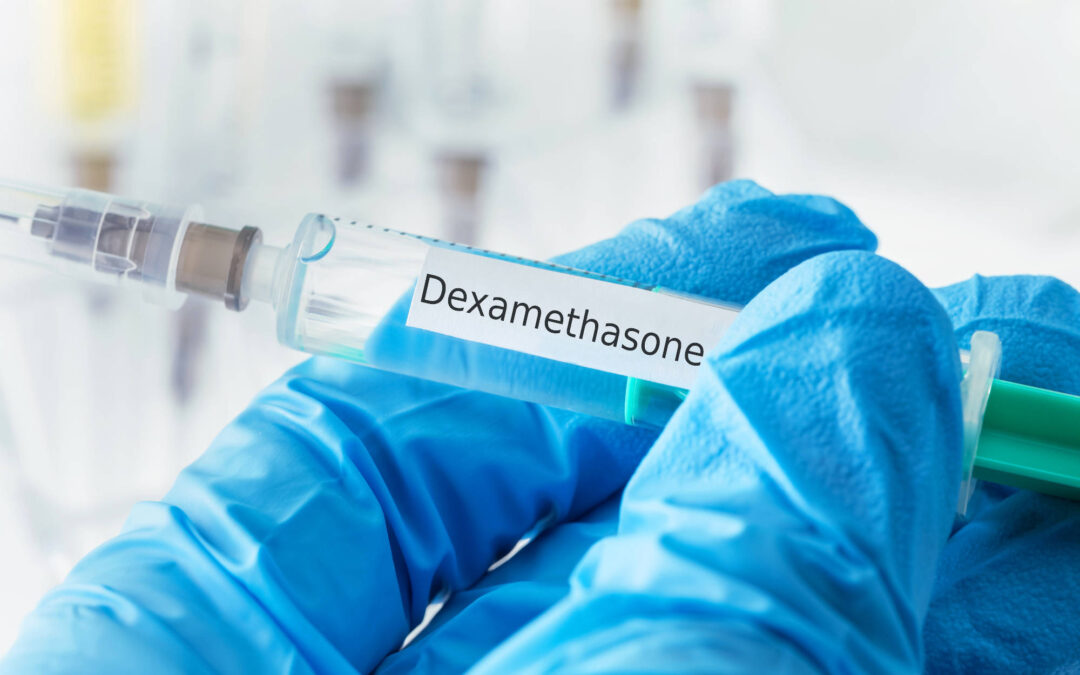Dexamethasone is a synthetic glucocorticoid administered before surgery to prevent postoperative nausea and vomiting (PONV). One of the most common complaints after surgery, roughly one in three patients suffer from PONV after undergoing general anesthesia [1], with many reporting that they would rather experience pain than nausea and vomiting [2]. PONV can precipitate postsurgical complications, such as dehydration, pulmonary aspiration, prolonged hospitalization, hospital readmission, and increased medical costs [3]. Therefore, preventing PONV presents a high priority for physicians, resulting in the prophylactic administration of the inexpensive, long-acting drug dexamethasone. Over 50% of patients undergoing general anesthesia receive this corticosteroid, which significantly reduces their risk of suffering from PONV [4]. While the anti-emetic properties of dexamethasone remain poorly understood, it has been established that the drug inhibits anti-inflammatory responses, suppresses the migration and proliferation of leukocytes, promotes prostaglandin production, and causes temporary hyperglycemia due to reversible insulin resistance [5, 6]. Thus, the immunosuppressive properties of dexamethasone have generated concern over the possibility of infection [4].
Dexamethasone, like natural glucocorticoids, changes how hormone secretory patterns respond to a stressor [7]. When activated during a stress response, glucocorticoids suppress the immune response by impeding the synthesis, release, and efficacy of cytokines and pro-inflammatory enzymes [7, 8]. Additionally, glucocorticoids inhibit antigen presentation, reduce the expression of major histocompatibility complex (MHC) proteins, and diminish the activation and migration of T and B cells [7]. Thus, these numerous immunosuppressive mechanisms of glucocorticoids have raised questions about the risk of surgical site infection after glucocorticoid administration, especially in diabetic patients [8]. Surgical site infections are serious yet common side effects after surgery and result in prolonged hospitalization, delayed wound healing, increased medical costs, and occasionally mortality [4]; therefore, concerns of surgical site infection are dire enough to prompt reassessment of dexamethasone use. However, studies have not shown any significant correlation between dexamethasone administration and surgical site infection.
Due to the growing concern, numerous studies have been conducted to determine the association between dexamethasone and surgical site infection [4, 9-12]. One meta-analysis of randomized controlled trials concluded that a single dose of dexamethasone — the typical protocol for preventing PONV — does not increase the risk of surgical site infection compared to no treatment, placebo, or antiemetic serotonin antagonists in adult surgical patients, although the authors noted that diabetic patients had been excluded from the analysis [9]. Another study with a massive sample size of 18,872 postoperative patients also concluded that a single 5-10 milligram dose of dexamethasone did not increase risk of infection compared to the control [10]. Furthermore, a study of 8,725 postoperative patients also concluded that dexamethasone was non-inferior to the placebo in patients with and without diabetes [4]. Therefore, the available evidence suggests that a single dose of dexamethasone does not increase the risk of surgical site infection.
To summarize, despite the fact that glucocorticoids such as dexamethasone cause immunosuppression by blocking the production and proliferation of cytokines, enzymes, and MHC proteins, a single dose of dexamethasone has not been found to increase the risk of surgical site infection. While long-term use and high dosages should be avoided, anesthesiologists continue to recommend the pre- or intraoperative administration of 4 to 8 milligrams of dexamethasone for PONV prophylaxis [12].
References
1: Pierre, S. and Whelan, R. (2012). Nausea and vomiting after surgery. Continuing Education in Anaesthesia Critical Care and Pain Recovery, vol. 13. DOI: 10.1093/bjaceaccp/mks046.
2: Sizemore, D., Singh, A., Dua, A., Singh, K., and Grose, B. (2021). Postoperative nausea. StatPearls. Online article. URL: https://www.ncbi.nlm.nih.gov/books/NBK500029/.
3: Shaikh, S., Nagarekha, D., Hegade, G., and Marutheesh, M. (2016). Postoperative nausea and vomiting: A simple yet complex problem. Anesthesia Essays and Researches, vol. 10. DOI: 10.4103/0259-1162.179310.
4: Corcoran, T., Myles, P., Forbes, A., Cheng, A., Bach, L., O’Loughlin, E., Leslie, K., Chan, M., Story, D., Short, T., Martin, C., Coutts, P., et al. (2021). Dexamethasone and surgical-site infection. New England Journal of Medicine, vol. 384. DOI: 10.1056/NEJMoa2028982.
5: Johnson, D., Lopez, M., and Kelley, B. (2020). Dexamethasone. StatPearls. Online article. URL: https://www.ncbi.nlm.nih.gov/books/NBK482130/.
6: Murphy, G., Szokol, J., Avram, M., Greenberg, S., Shear, T., Vender, J., Gray, J., and Landry, E. (2014). The effect of single low-dose dexamethasone on blood glucose concentrations in the perioperative period. Anesthesia and Analgesia, vol. 118. DOI: 10.1213/ANE.0b013e3182a53981.
7: Bain, C., Draxler, D., Taylor, R., Wallace, S., Gouldthorpe, O., Cocoran, T., Myles, P., Medcalf, R., and Bozaoglu, K. (2018). The early in-vivo effects of a single anti-emetic dose of dexamethasone on innate immune cell gene expression and activation in healthy volunteers. Anaesthesia, vol. 73. DOI: 10.1111/anae.14306.
8: Turan, A. and Sessler, D. (2011). Steroids to ameliorate postoperative pain. Anesthesiology, vol. 115. DOI: 10.1097/ALN.0b013e31822a2871.
9: Polderman, J., Farhang-Razi, V., Van Dieren, S., Kranke, P., DeVries, J., Hollmann, M., Preckel, B., and Hermanides, J. (2018). Adverse side effects of dexamethasone in surgical patients. Cochrane Database of Systematic Reviews. DOI: 10.1002/14651858.CD011940.pub2.
10: Vuorinen, M., Palanne, R., Mäkinen, T., Leskinen, J., Huhtala, H., and Huotari, K. (2019). Infection safety of dexamethasone in total hip and total knee arthroplasty: a study of eighteen thousand, eight hundred and seventy two operations. International Orthopedics, vol. 43. DOI: 10.1007/s00264-018-4156-8.
11: Assante, J., Collins, S., and Hewer, I. (2015). Infection associated with single-dose dexamethasone for prevention of postoperative nausea and vomiting: a literature review. American Association of Nurse Anesthetists Journal, vol. 83. Online article. URL: https://pubmed.ncbi.nlm.nih.gov/26390747/.
12: Khan, S., McDonagh, D., and Gan, T. (2013). Wound complications with dexamethasone for postoperative nausea and vomiting prophylaxis: a moot point? Anesthesia and Analgesia, vol. 116. DOI: 10.1213/ANE.0b013e31828a73de.







Recent Comments